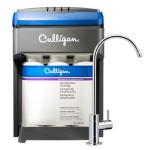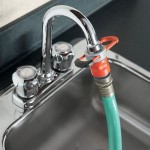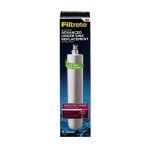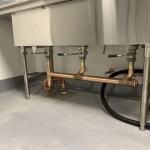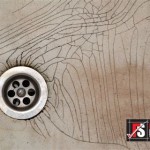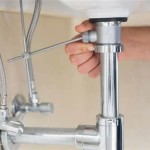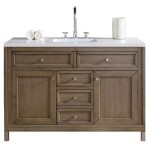Unclogging A Kitchen Sink Drain
A clogged kitchen sink drain is a common household problem that can disrupt daily routines. Accumulation of food particles, grease, hair, and other debris often contribute to blockages within the drainpipe. Addressing the issue promptly and effectively is key to preventing further complications, such as foul odors, water damage, and potential plumbing emergencies. Several methods exist for unclogging a kitchen sink drain, ranging from simple DIY approaches to more intricate professional solutions.
Before initiating any unclogging procedure, it is important to assess the severity of the clog. A slow-draining sink might indicate a partial blockage that can be resolved with relatively simple techniques. A completely blocked drain, characterized by standing water in the sink, requires a more aggressive approach. Examining the drain strainer and removing any visible debris is the first step. Sometimes, this minor intervention is sufficient to restore proper drainage.
Boiling Water Flush
One of the simplest and often overlooked methods for unclogging a kitchen sink drain involves using boiling water. This technique is most effective for dissolving grease and soap buildup. Carefully pour a kettle full of boiling water directly down the drain. The hot water can help to melt and dislodge greasy substances, allowing them to flow freely through the pipes. Exercise caution when handling boiling water to avoid burns. If the drain remains clogged after the initial flush, repeat the process a couple of times. This method is generally safe for most pipes, but it should be avoided if the sink is made of porcelain or if PVC pipes are present, as the extreme heat can potentially damage these materials.
For added effectiveness, consider adding a small amount of dish soap to the boiling water. The dish soap can help to break down grease and improve the overall cleaning action. It is also important to note that this method is most effective for recent clogs and may not be sufficient for more stubborn blockages that have accumulated over time.
In situations where boiling water alone proves insufficient, other techniques may be considered. These options range from using chemical drain cleaners to more mechanical approaches, such as using a plunger or a drain snake. Each method has its own advantages and disadvantages, and the choice of technique should be based on the specific nature of the clog and the type of plumbing system in place.
Plunger Application
Using a plunger is a time-tested method for dislodging clogs in a kitchen sink drain. The plunger works by creating suction and pressure, which can effectively break up the blockage. To use a plunger effectively, ensure there is enough water in the sink to cover the cup of the plunger. If the sink has two basins, seal off the second drain opening with a wet cloth or a stopper to prevent air from escaping. This ensures that the plunging action is concentrated on the clogged drain.
Place the plunger over the drain opening, ensuring a tight seal. Begin plunging vigorously, maintaining the seal throughout the process. Plunge up and down for several minutes, then remove the plunger to see if the water drains. If the water still does not drain, repeat the plunging process until the clog is dislodged. The key to successful plunging is to create a strong vacuum and apply consistent pressure. A flange-type plunger, which has a soft rubber flap that folds out from inside the cup, is often more effective for kitchen sinks as it creates a better seal around the drain opening.
If the plunger method fails to clear the clog, it may indicate a more serious blockage deeper within the drainpipe. In such cases, other methods such as using a drain snake or chemical drain cleaners may be considered. However, it is crucial to exercise caution when using chemical drain cleaners, as they can be harmful to both the plumbing system and the environment.
Plungers are a cost-effective and readily available tool for addressing minor clogs in kitchen sinks. They are a good first step when dealing with a slow-draining sink and can often resolve the issue without the need for more complex solutions. However, it is important to use the plunger correctly and to maintain a good seal around the drain opening to maximize its effectiveness.
Baking Soda and Vinegar Solution
A natural and effective alternative to chemical drain cleaners is a mixture of baking soda and vinegar. This method utilizes a chemical reaction to break down grease and debris within the drainpipe. Start by pouring one cup of baking soda down the drain, followed by one cup of white vinegar. The combination will create a fizzing action as the baking soda reacts with the vinegar. Allow the mixture to sit in the drain for approximately 30 minutes.
After 30 minutes, flush the drain with hot water. The hot water will help to wash away the loosened debris. This method is generally safe for most types of pipes and is an environmentally friendly option. The baking soda and vinegar solution works by creating carbon dioxide gas, which helps to dislodge the clog. It is important to allow sufficient time for the reaction to occur to maximize its effectiveness.
For persistent clogs, the baking soda and vinegar treatment can be repeated multiple times. In some cases, allowing the mixture to sit overnight can further enhance its effectiveness. This method is particularly useful for breaking down organic matter and grease buildup. While baking soda and vinegar may not be as powerful as some chemical drain cleaners, it is a safer and more sustainable option.
In addition to its unclogging properties, the baking soda and vinegar solution can also help to freshen the drain and eliminate unpleasant odors. Regular use of this method can help to prevent clogs from forming in the first place. It is a simple and convenient way to maintain a healthy drain system.
If the baking soda and vinegar method fails to clear the clog, it may be necessary to consider other options, such as using a drain snake or seeking professional assistance. However, for minor clogs and preventative maintenance, baking soda and vinegar is a reliable and effective solution.
Beyond the previously mentioned methods, other approaches can be employed to unclog a kitchen sink drain. A wet/dry vacuum can be used to attempt to suck out the clog. This involves placing the vacuum hose over the drain opening and creating a tight seal. Alternatively, disassembling the P-trap under the sink allows for direct access to the drainpipe and can reveal the source of the blockage. When reassembling, ensure all connections are tightened properly to prevent leaks.
Prevention is always better than cure. To minimize the risk of future clogs, avoid pouring grease down the drain. Dispose of food scraps in the trash or compost bin. Regularly flush the drain with hot water to prevent buildup. Consider using a drain strainer to catch food particles and hair before they enter the drainpipe. By implementing these preventative measures, the frequency of clogs can be significantly reduced.
In persistent or severe cases, professional plumbing assistance may be required. Plumbers have specialized tools and expertise to diagnose and resolve complex drain problems. Attempting to repair a complicated plumbing issue without the proper knowledge and equipment can potentially lead to further damage and costly repairs. Knowing when to seek professional help is crucial for maintaining a healthy plumbing system.

How To Unblock A Kitchen Sink 7 Methods Qs

How To Unclog A Sink Herrmann Services

How To Unclog A Kitchen Sink Drain

How To Unclog A Kitchen Sink Drain

How To Unclog A Kitchen Sink Family Handyman

How To Unclog A Kitchen Sink Using Baking Soda And Vinegar

How To Clean And Unclog A Kitchen Sink Drain Diy Family Handyman

How To Unclog A Kitchen Sink Drain

How To Unclog A Kitchen Sink Drain By Home Repair Tutor

How To Fix A Clogged Sink Unclog Your
